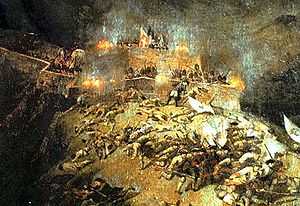Battle of Assietta
| ||||||||||||||||||||||||||||||
| ||||||||||||||||||||||||||||||
The Battle of Assietta was fought in the Italian campaign of the War of the Austrian Succession on 19 July 1747. It resulted in a defeat for France against the army of the Kingdom of Sardinia.
Background
In the late phase of the War of the Austrian Succession, France had decided to eliminate the Savoy-Piedmontese army, considered dangerous due to its strong strategic position. King Louis XV had already tried to penetrate into Piedmont, besieging Cuneo and fighting at Madonna dell'Olmo and Bassignana.
A French army comprising 150 infantry regiments, 75 cavalry squadrons and 2 artillery brigades, under the command of Marshal Charles Louis Auguste, duke of Belle-Isle, and Marquis De La Mina. The two commanders had different views on the lead of the campaign: Belle-Isle favoured a direct menace to Turin by crossing the Alps, while his Spanish colleague preferred to send troops to relieve the Austro-Piedmontese siege of Genoa.
Belle-Isle's ideas prevailed and the French troops occupied Antibes as well as the county of Nice. However, they were halted by the strong Piedmontese defence of the southern Alpine passes. Belle-Isle's brother, the Chevalier de Belle-Isle, led an army of 50 infantry battalions, 15 cavalry squadrons and numerous cannon advanced towards the northern passes.
The army was divided into two corps: one descended from the Moncenisio towards Exilles while the other advanced towards Fenestrelle from the Assietta Pass. The latter is a bare plateau at more than 2,500 meters of altitude. Although he outnumbered the French in the area 50,000 to 25,000[1] Charles Emmanuel III of Savoy was forced to defend all the passes into his country while the French could concentrate their force and attack one place. The decision was made to advance through Assietta. The Piedmontese had fortified the area with 13 infantry battalions: 9 Piedmontese, the remaining were Austrian and Swiss taken from the troops that had unsuccessfully besieged Genoa.
French intelligence notified the marshals that the Piedmontese were fortifying the pass, and a decision to attack immediately was taken. Numerous obstacles, redoubts and an 18 foot high palisade, had been built on the slope.
The forces involved amounted to 32 French battalions against 13 Piedmontese battalions. The French troops were divided into three columns with the center column pressing the attack and the flank columns failing to have much effect. The attacks began at about 16:30. Despite the desperate effort of the soldiers and the personal show of valour of the French marshals, all four attacks were repulsed by the Piedmontese with heavy losses. After five hours of battle, the French retreated. The French commander, Chevalier de Belle-Isle, was killed raising the French flag near the top of the slope. What ensued in the late afternoon was celebrated as the most one-sided slaughter of the war. Neither the flanking columns moved decisively enough to influence events in. These, lashed by determined officers, the French struggled up the slope, disassembling the various man-made impediments as they proceeded, while withering musket fire from concealed and protected hideouts exacted the heavy toll. Four times the French fell back before the onslaught; each time they returned to the struggle. The living climbed over the piles of dead as they tried to surmount the palisades.Defenders rained bullets and rocks down on the relentless blood-drenched attackers. A retreat, more orderly then the butchery,was portended The one-sided character of the slaughter was apparent-French casualties totaled, and for the first and the only times in the war the majority of them (3700) were fatalities 5,300 Casualties were 5,300, including 7 generals, for the French; while only 299 Piedmontese were killed and wounded.
The beaten French troops returned to France. Frederick II of Prussia, after hearing of news of the Piedmontese defence at Assietta, declared that, if he had had such valorous troops, he could easily become King of Italy.
References
Bibliography
- Browning, Reed (2008). The War of the Austrian Succession. St. Martin's Griffin. ISBN 0-312-12561-5
- Dabormida, Vittorio (1891). La battaglia dell'Assietta : studio storico. Voghera.
- Alberti, Adriano (1902). La battaglia dell'Assietta (19 di luglio del 1747): note e documenti. Francesco Casanova.
- Rodolico, Niccolò (July–August 1947). "Il Centenario della Battaglia dell'Assietta". L'Universo (Istituto Geografico Militare) (4.XXVII).
